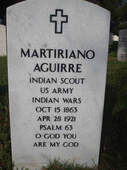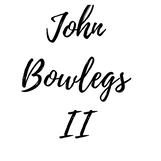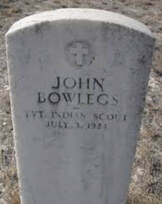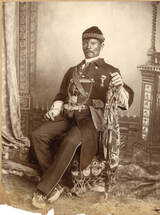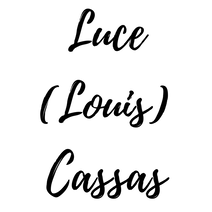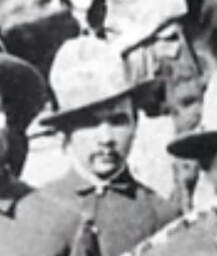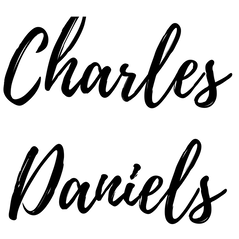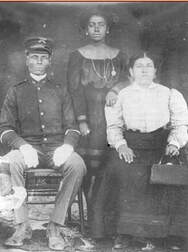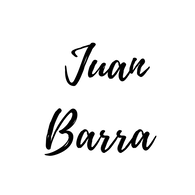
Juan Barra was a Seminole Negro Indian Scout who was born in Mexico. He’s listed as having black eyes, black hair, a copper complexion, and standing 5’8”.
He was a private who enlisted from May 26, 1880 to June 6, 1881 and from June 7, 1881 to June 6, 1882. He was stationed at Fort Clark and served under Lt. Bullis.
In the 1880 census, he was listed as a white male, age 27. His wife, Austacio, was listed as a white female, age 20. They had one child, Leonides, who was listed as a white female, age 4.
He was a private who enlisted from May 26, 1880 to June 6, 1881 and from June 7, 1881 to June 6, 1882. He was stationed at Fort Clark and served under Lt. Bullis.
In the 1880 census, he was listed as a white male, age 27. His wife, Austacio, was listed as a white female, age 20. They had one child, Leonides, who was listed as a white female, age 4.

Espetacion Barrera was a Seminole Negro Indian Scout who was born in Mexico. He had hazel eyes, black hair, a copper complexion, and stood 5’7”. As a private, he completed three enlistments:
February 8, 1878 to April 24, 1879
April 25, 1878 to May 11, 1880
May 30, 1880 to June 6,1881
He was stationed at Fort Clark and served under Lt. Bullis. In the 1880 census, Espetacion Barrera was listed as a white male who was 21 years old. His wife, Elsa, was listed as a 19-year-old black female who had been born in Mexico.
February 8, 1878 to April 24, 1879
April 25, 1878 to May 11, 1880
May 30, 1880 to June 6,1881
He was stationed at Fort Clark and served under Lt. Bullis. In the 1880 census, Espetacion Barrera was listed as a white male who was 21 years old. His wife, Elsa, was listed as a 19-year-old black female who had been born in Mexico.

David Bowlegs was a Seminole Negro Indian Scout who was born in Florida. He had black eyes, black hair, and a black complexion. He stood 5’8”. He was, first, a corporeal and, then, a 1st sergeant who completed 12 enlistments from May 1, 1873 to May 12, 1882. During his service, he was stationed at Ft. Duncan, Palafox, Ft. Concho, Pecos, Crow Cruz, and Ft. Clark, and he served under Lt. Callahan, Cpt. Cunningham, Lt. Markley, and Lt Bullis.
His wife’s name was Nancy, and they had seven children — Priscilla, Leah, Pompy, Sandy, Davis, Camelia, and Noble.
Following his service, David Bowlegs, along with 37 other people, went on a personal mission to the Seminole Nation in Indian Territory. This is the only group of Seminole Negro Indian Scouts known to have returned to the Seminole Nation.
According to Kevin Mulroy in The Seminole Freedmen: A History, “In the summer of 1881, Sgt. David Bowlegs rode out of the Seminole Negro Indian Settlement at Las Moras Creek in the Ft. Clark military reservation to visit his kinsmen among the Freedmen in the Indian Territory. Liking what he saw, he took a favorable report back to Texas: “If I had no one but myself and my wife, I would rather soldier than do anything else I know of, but I have a large family growing up and we are here where we own nothing, and can get no work. My children will grow up idle and become criminals on this frontier. I have been raised like an Indian, but want to go to my people and settle in a home and teach my children to work and most of my people are like me.”
His wife’s name was Nancy, and they had seven children — Priscilla, Leah, Pompy, Sandy, Davis, Camelia, and Noble.
Following his service, David Bowlegs, along with 37 other people, went on a personal mission to the Seminole Nation in Indian Territory. This is the only group of Seminole Negro Indian Scouts known to have returned to the Seminole Nation.
According to Kevin Mulroy in The Seminole Freedmen: A History, “In the summer of 1881, Sgt. David Bowlegs rode out of the Seminole Negro Indian Settlement at Las Moras Creek in the Ft. Clark military reservation to visit his kinsmen among the Freedmen in the Indian Territory. Liking what he saw, he took a favorable report back to Texas: “If I had no one but myself and my wife, I would rather soldier than do anything else I know of, but I have a large family growing up and we are here where we own nothing, and can get no work. My children will grow up idle and become criminals on this frontier. I have been raised like an Indian, but want to go to my people and settle in a home and teach my children to work and most of my people are like me.”

Friday Bowlegs was a Seminole Negro Indian Scout who was born in Florida. He had black eyes, black hair, and a black complexion. He was six feet tall.
He completed 12 enlistments, starting December 1, 1872 and ending December 26, 1885. As a private, he was stationed at Fort Duncan, San Antonio, and Fort Clark, and served under Cpt. Beyer, Lt. Markley, Lt. Valois, Lt. Dougherty, Lt. Jones, Lt. French, Lt. Howell, Lt. Hall, and Lt. Bullis.
Special Note: All Bowlegs born in Florida were either former enslaved Africans or descended from enslaved Africans who belonged to Seminole Chief Bowlegs (Bowlik).
He completed 12 enlistments, starting December 1, 1872 and ending December 26, 1885. As a private, he was stationed at Fort Duncan, San Antonio, and Fort Clark, and served under Cpt. Beyer, Lt. Markley, Lt. Valois, Lt. Dougherty, Lt. Jones, Lt. French, Lt. Howell, Lt. Hall, and Lt. Bullis.
Special Note: All Bowlegs born in Florida were either former enslaved Africans or descended from enslaved Africans who belonged to Seminole Chief Bowlegs (Bowlik).
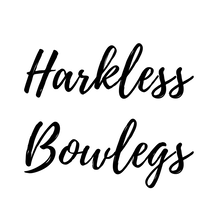
Harkless Bowlegs was a Seminole Negro Indian Scout who was born in Mexico. He had black eyes, black hair, and a black complexion. He stood 5’8”. As a private, he completed 4 enlistments, serving from May 14, 1881 to August 31, 1884. He was stationed at Ft. Clark, Pecos, and Ft. Myers and served under Lt. Jones, Lt. French, Lt. Howell, and Lt. Bullis.
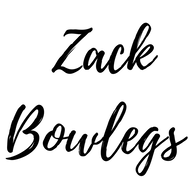
Zack Bowlegs was a Seminole Negro Indian Scout who was born in Florida. He had black eyes, black hair, and a black complexion. He was six feet tall.
He was a private who was stationed at Ft. Duncan. Under the command of Cpt. Boyer, he served from December 1, 1872 to June 1, 1873. It is generally believed that those with the surname Bowlegs had either been enslaved by or had descended from those who had been enslaved by Seminole Chief Bowlegs.
He was a private who was stationed at Ft. Duncan. Under the command of Cpt. Boyer, he served from December 1, 1872 to June 1, 1873. It is generally believed that those with the surname Bowlegs had either been enslaved by or had descended from those who had been enslaved by Seminole Chief Bowlegs.

Cipio Bruner was a Seminole Negro Indian Scout who was born in Mexico. He had black eyes, black hair, and a copper complexion. He was 5’6”.
He was a private who enlisted four times, serving from August 12, 1872 to December 17, 1874. He was stationed at Ft. Clark and served under Lt. Land, Lt. Cranston, Lt. Parker, and Lt. Bullis.
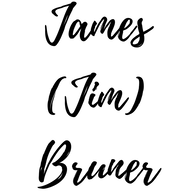
James (Jim) Bruner was a Seminole Negro Indian Scout who was born in Mexico. He had black eyes, black hair, and a black complexion. He stood 5’10”.
He completed eight enlistments, serving from November 9, 1871 to July 11, 1881. He began as a private. On June 30, 1873, he became a sergeant, and on July 12, 1880, he became a corporal.
In the 1880 census, his wife’s name was listed as Lucy, and they had four children — Maltilde (7), Didia (6), William (4), and James (4).
He completed eight enlistments, serving from November 9, 1871 to July 11, 1881. He began as a private. On June 30, 1873, he became a sergeant, and on July 12, 1880, he became a corporal.
In the 1880 census, his wife’s name was listed as Lucy, and they had four children — Maltilde (7), Didia (6), William (4), and James (4).
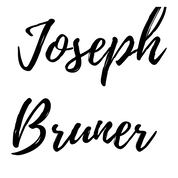
Joseph Bruner was a Seminole Negro Indian Scout who was born in Alabama. He had black eyes, black hair, and a black complexion. He stood 5’10”.
He was a private who completed one enlistment. He served from August 12, 1872 to March 6, 1873. He was stationed at Fort Clark and served under Lt. Land.
FYI: Also, the surname Bruner had alternate spellings — Brune or Bruno. Thanks to Jay Payne for this additional information.
He was a private who completed one enlistment. He served from August 12, 1872 to March 6, 1873. He was stationed at Fort Clark and served under Lt. Land.
FYI: Also, the surname Bruner had alternate spellings — Brune or Bruno. Thanks to Jay Payne for this additional information.

Monday Bruner was a Seminole Negro Indian Scout who was born in Arkansas. He had black eyes, black hair, and a black complexion. He was 6’2”.
He was a private who served from August 2, 1872 to May 17, 1875. He was listed as having deserted the military. He was stationed at Fort Duncan and Fort Clark and served under Lt. Beyer, Lt. Capistan, Lt. Kirkman, and Lt. Bullis.

Peter Bruner was a Seminole Negro Indian Scout who was born in Arkansas (Indian Territory). He had black eyes, black hair, and a black complexion. He stood six feet tall.
He was a private who completed nine enlistments, serving from August 2, 1872 to August 19, 1881. He was stationed at Ft. Duncan, Comanche, Palafox, and Ft. Clark. He served under Lt. Beyer, Lt. Parker, Lt. Markley, and Lt. Bullis.
In the 1880 census, he was listed as a 32-year-old black male. His wife, Alvina, was listed as a 37-year-old black female. They had one child, a 3-year-old girl named Adelia.
He was a private who completed nine enlistments, serving from August 2, 1872 to August 19, 1881. He was stationed at Ft. Duncan, Comanche, Palafox, and Ft. Clark. He served under Lt. Beyer, Lt. Parker, Lt. Markley, and Lt. Bullis.
In the 1880 census, he was listed as a 32-year-old black male. His wife, Alvina, was listed as a 37-year-old black female. They had one child, a 3-year-old girl named Adelia.
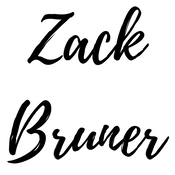
Zack Bruner was a Seminole Negro Indian Scout who was born in Mexico. He had black eyes, black hair, and a black complexion. He stood 5’7”.
He was a private who completed eight enlistments, serving from November 9, 1871 to July 11, 1880. He was stationed at Fort Duncan, Fort Concho, and Fort Clark and served under Major Bliss, Cpt. Beyer, Lt. Gower, Lt. Parker, Lt. Bullis, and Lt. Durst.
His wife’s name was Jennie, and their children’s names were Juno and Susie.
He was a private who completed eight enlistments, serving from November 9, 1871 to July 11, 1880. He was stationed at Fort Duncan, Fort Concho, and Fort Clark and served under Major Bliss, Cpt. Beyer, Lt. Gower, Lt. Parker, Lt. Bullis, and Lt. Durst.
His wife’s name was Jennie, and their children’s names were Juno and Susie.

Joe Cook was a Seminole Negro Indian Scout who was born in Arkansas (Indian Territory). He had black eyes, black hair, and a black complexion. He stood 5’4”.
As a private, he began his service on August 2, 1872. He completed nine enlistments. He died on December 16, 1886 while serving his tenth enlistment. He was killed by a railroad car in Mason Spring, Texas.
He was stationed at Ft. Duncan, Ft. Clark, Cp. Painted, and Cp Myers. He served under Lt. Beyer, Lt. Cranston, Lt. Bullis, Lt. Campbell, and Lt. Hall.
In addition to being a private, he also was a blacksmith and a saddler. In the 1880 census, he was listed as a cook. At the time of the census, he was listed as a 40-year-old black male.
As a private, he began his service on August 2, 1872. He completed nine enlistments. He died on December 16, 1886 while serving his tenth enlistment. He was killed by a railroad car in Mason Spring, Texas.
He was stationed at Ft. Duncan, Ft. Clark, Cp. Painted, and Cp Myers. He served under Lt. Beyer, Lt. Cranston, Lt. Bullis, Lt. Campbell, and Lt. Hall.
In addition to being a private, he also was a blacksmith and a saddler. In the 1880 census, he was listed as a cook. At the time of the census, he was listed as a 40-year-old black male.

Joe Coon was a Seminole Negro Indian Scout who was born in Arkansas (Indian Territory). He had black eyes, black hair, and a black complexion. He stood 5’8”.
He was a private who completed six enlistments, serving from August 2, 1872 to April 23, 1879. He was stationed at Ft. Duncan, Cp. Comanche, Ft. Clark, Cp. Pecos, and Cp. Painted, and he served under Lt. Beyer, Lt. Bullis, and Lt. Markey.
John Horse (aka Juan Cavallo and Gopher John) was Joe Coon’s father. Coon’s mother was probably John Horse’s first wife because his last wife’s age was within two years of Joe Coon’s age.
Special Note: Coon was a common Seminole surname.
He was a private who completed six enlistments, serving from August 2, 1872 to April 23, 1879. He was stationed at Ft. Duncan, Cp. Comanche, Ft. Clark, Cp. Pecos, and Cp. Painted, and he served under Lt. Beyer, Lt. Bullis, and Lt. Markey.
John Horse (aka Juan Cavallo and Gopher John) was Joe Coon’s father. Coon’s mother was probably John Horse’s first wife because his last wife’s age was within two years of Joe Coon’s age.
Special Note: Coon was a common Seminole surname.
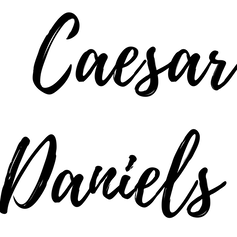
Caesar Daniels was a Seminole Negro Indian Scout who was born in Texas. He had black eyes, black hair, and a dark complexion.
He stood 5’8” tall.
As a private, he completed five enlistments, serving from March 8, 1901 to August 31, 1914. He was stationed at Ft. Ringold and Ft. Clark. He served under Lt. Read, Lt. Blastard, Cpt. Babcock, Lt. Barney, and Lt. Kellam.
He was one of the men serving when the Seminole Negro Indian Scouts were disbanded.
Caesar Daniels was honorably discharged while he was stationed at Fort Clark following 13 years and 5 months of service.
Daniels was a Black Creek whose family left Indian Territory. He passed away on June 19, 1919 and is buried at the Seminole Indian Scouts Cemetery in Brackettville, Texas.
He stood 5’8” tall.
As a private, he completed five enlistments, serving from March 8, 1901 to August 31, 1914. He was stationed at Ft. Ringold and Ft. Clark. He served under Lt. Read, Lt. Blastard, Cpt. Babcock, Lt. Barney, and Lt. Kellam.
He was one of the men serving when the Seminole Negro Indian Scouts were disbanded.
Caesar Daniels was honorably discharged while he was stationed at Fort Clark following 13 years and 5 months of service.
Daniels was a Black Creek whose family left Indian Territory. He passed away on June 19, 1919 and is buried at the Seminole Indian Scouts Cemetery in Brackettville, Texas.
|
The scout of the day is First Sergeant Charles Daniels.
Charles Daniels was a Seminole Negro Indian Scout who was born in Mexico. He was a member of the Black Creeks who had moved to Mexico from Indian Territory. He had black eyes, black hair, and a black complexion. He stood 5’8”. He completed 25 enlistments, serving from October 7, 1871 to October 4, 1909. He began as a private. He was promoted to corporal on February 1, 1879, sergeant on February 2, 1880, and first sergeant on June 9, 1894 (retired rank). He was stationed at Fort Duncan, Fort Clark, Cp. Neville, AquaNueve, and Fort Ringold. He served under Major Bliss, Cpt. Beyer, Lt. Land, Lt. Cranton, Lt. Parker, Lt. Bullis, Lt. Longbrough, Lt. Jones, Lt. French, Lt. Hall, Lt. Kendall, Lt. Shanks, Cpt. Bourke, Lt. Vesta, Lt. Wade, Lt. Fonda, Lt. Bladad, and Cpt. Babcock. Charles Daniels died on January 10, 1931. He was buried at the Seminole Indian Scouts Cemetery in Brackettville, Texas. According to the website seminolenation-indianterritory.org, the photo is of First Sergeant Charles Daniels, his wife Mary, and daughter Tina. “Daniels first enlisted with the scouts in 1871 and saw service during the most intense period of the Texas Indian Wars. He retired in 1909, just five years before the unit disbanded.” According to the Black Canadian Veterans’ Stories Facebook page, this photo was taken at Fort Davis, Texas, and Daniels is wearing a 1902 model dress uniform. |

The Scout of the Day is Sergeant Elijah Daniels.
Elijah Daniels was a Seminole Negro Indian Scout who was born in Arkansas (Indian Territory). He had black eyes, black hair, and a black complexion. He was 5’10”.
As a private and, later, a sergeant, Elijah Daniels completed nine enlistments, serving from October 7, 1871 to November 22, 1876. He was stationed at Fort Duncan and Fort Clark and served under Major Bliss, Lt. Cranton (or Cranston), Lt. Parker, Lt Bullis, and Lt. Land.
The Elijah Daniels Band of Creek Negro Indians were reported by the Department of Texas as being encamped on the Nueces River in 1870. The commanding colonel tried to encourage a ranger company from D’Hanis to enlist them, but this attempt was to no avail.
Some books would lead you to believe Elijah Daniels’ Band was the first to enlist at Fort Clark; however, please note that, during his second enlistment, he was transferred to Fort Clark, as were other members of his band. While he may have been chief of the Black Creeks, he wasn’t the chief of all those at Fort Clark until, at least, the death of Black Seminole Chief John Kibbetts, who passed away on September 7, 1878.
Elijah Daniels passed away on January 12, 1908 and his body was interred at Seminole Indian Scouts Cemetery in Brackettville, Texas.
Elijah Daniels was a Seminole Negro Indian Scout who was born in Arkansas (Indian Territory). He had black eyes, black hair, and a black complexion. He was 5’10”.
As a private and, later, a sergeant, Elijah Daniels completed nine enlistments, serving from October 7, 1871 to November 22, 1876. He was stationed at Fort Duncan and Fort Clark and served under Major Bliss, Lt. Cranton (or Cranston), Lt. Parker, Lt Bullis, and Lt. Land.
The Elijah Daniels Band of Creek Negro Indians were reported by the Department of Texas as being encamped on the Nueces River in 1870. The commanding colonel tried to encourage a ranger company from D’Hanis to enlist them, but this attempt was to no avail.
Some books would lead you to believe Elijah Daniels’ Band was the first to enlist at Fort Clark; however, please note that, during his second enlistment, he was transferred to Fort Clark, as were other members of his band. While he may have been chief of the Black Creeks, he wasn’t the chief of all those at Fort Clark until, at least, the death of Black Seminole Chief John Kibbetts, who passed away on September 7, 1878.
Elijah Daniels passed away on January 12, 1908 and his body was interred at Seminole Indian Scouts Cemetery in Brackettville, Texas.

Sergeant Jerry Daniels is today’s Scout of the Day.
Jerry Daniels was a Seminole Negro Indian Scout who was born in Mexico. He was a Black Creek. He had black eyes, black hair, and a black complexion. He was 5’8”.
He completed nine enlistments, serving from August 31, 1871 to May 1, 1880. He began as a private but was promoted to corporal. Then, on May 31, 879, by Special Order 113 from the Department of Texas, Jerry Daniels was made a sergeant in lieu of Washington (not sure of his first name) being discharged.
In the 1880 census, Jerry was listed as a 27-year-old black male. He was a farmer. His wife, Jam, was listed as a 24-year-old black female. Their daughter, Judia, was listed as a 7-year-old black female.
Jerry passed away on January 29, 1925. He was buried at the Seminole Indian Scouts Cemetery in Brackettville, Texas.
Jerry Daniels was a Seminole Negro Indian Scout who was born in Mexico. He was a Black Creek. He had black eyes, black hair, and a black complexion. He was 5’8”.
He completed nine enlistments, serving from August 31, 1871 to May 1, 1880. He began as a private but was promoted to corporal. Then, on May 31, 879, by Special Order 113 from the Department of Texas, Jerry Daniels was made a sergeant in lieu of Washington (not sure of his first name) being discharged.
In the 1880 census, Jerry was listed as a 27-year-old black male. He was a farmer. His wife, Jam, was listed as a 24-year-old black female. Their daughter, Judia, was listed as a 7-year-old black female.
Jerry passed away on January 29, 1925. He was buried at the Seminole Indian Scouts Cemetery in Brackettville, Texas.

Private John Daniels is the Scout of the Day.
John Daniels was a Seminole Negro Indian Scout who was born in Texas. He had black eyes, black hair, and a black complexion. He was 5’7”.
He completed three enlistments, serving from June 29, 1907 to June 31, 1914. He was stationed at Ft. Clark and served under Cpt. Babcock, Lt. Barney, and Lt. Denton. John Daniels was listed as one of the Scouts who were actively enlisted when the Seminole Negro Indian Scouts were terminated. He was honorably discharged.
He died on July 5, 1923 and was buried in the Seminole Indian Scouts Cemetery in Brackettville, Texas
John Daniels was a Seminole Negro Indian Scout who was born in Texas. He had black eyes, black hair, and a black complexion. He was 5’7”.
He completed three enlistments, serving from June 29, 1907 to June 31, 1914. He was stationed at Ft. Clark and served under Cpt. Babcock, Lt. Barney, and Lt. Denton. John Daniels was listed as one of the Scouts who were actively enlisted when the Seminole Negro Indian Scouts were terminated. He was honorably discharged.
He died on July 5, 1923 and was buried in the Seminole Indian Scouts Cemetery in Brackettville, Texas

The Scout of the Day is Private Thomas Daniels.
Thomas Daniels was a Seminole Negro Indian Scout who was born in Texas. He had black eyes, black hair, and a black complexion. He stood 5’6”.
He completed six enlistments, serving from January 23, 1894 to October 5, 1909. He was stationed at Fort Clark and Fort Ringold, and he served under Lt. Hardin, Lt. Vestal, Lt. Dapray, Lt. Font, Lt. Bladad, and Cpt. Babcock.
Thomas Daniels was a Seminole Negro Indian Scout who was born in Texas. He had black eyes, black hair, and a black complexion. He stood 5’6”.
He completed six enlistments, serving from January 23, 1894 to October 5, 1909. He was stationed at Fort Clark and Fort Ringold, and he served under Lt. Hardin, Lt. Vestal, Lt. Dapray, Lt. Font, Lt. Bladad, and Cpt. Babcock.

